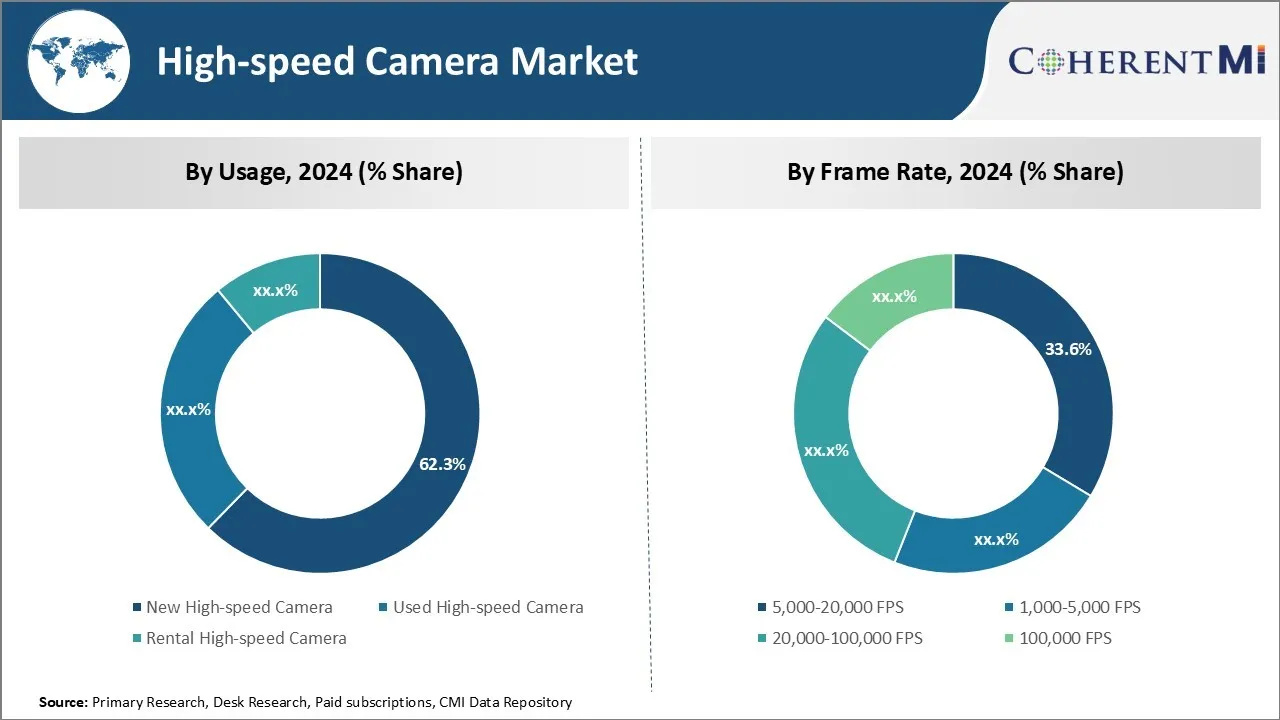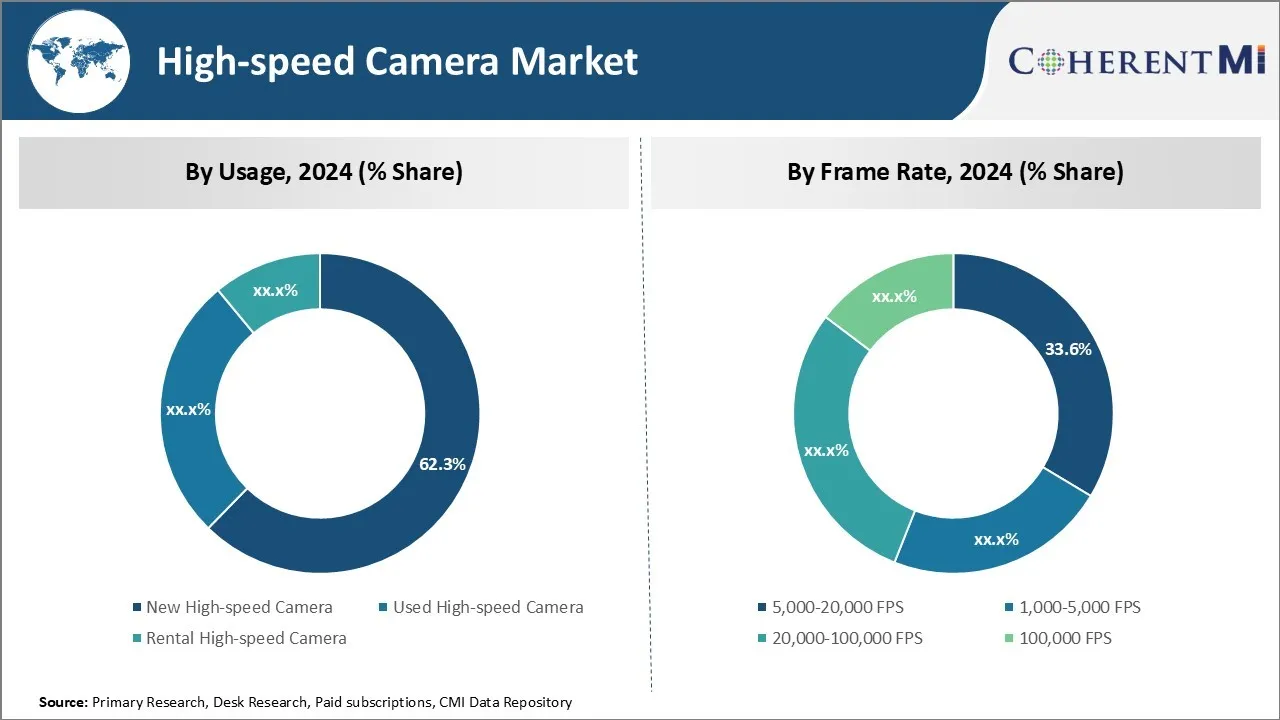高速度カメラ市場 規模およびシェア分析 - 成長トレンドおよび予測 (2024 - 2031)
高速カメラ市場は、用途別(新品高速カメラ、中古高速カメラ、レンタル高速カメラ)、フレームレート別(5,000~20,000 FPS、1,000~5,000 FPS、20,000~100,000 FPS...
高速度カメラ市場 サイズ - 分析
高速カメラ市場が評価されると推定される USD 666.81 Mn で 2024 そして到達する予定 米ドル 1,535.1 によって Mn 2031、混合の年次成長率で育つ 2024年から2031年にかけて12.65%のCAGR。 高速カメラ市場は、スポーツ分析における高速カメラの採用や科学的研究開発活動への投資の増加などの要因に起因する重要な成長を目撃する見込みです。
市場規模(米ドル) Mn
CAGR12.65%
| 調査期間 | 2024 - 2031 |
| 推定の基準年 | 2023 |
| CAGR | 12.65% |
| 市場集中度 | Medium |
| 主要プレーヤー | 株式会社ビジョンリサーチ, オリンパス株式会社, AOSテクノロジーAG, ナック 画像技術, ミクロトロン GMBH その他 |
お知らせください!
高速度カメラ市場 トレンド
市場ドライバー - 産業用途における精密需要増加
製造業の競争を増加させれば、精密および正確さの必要性は年上の著しく増加しました。 高速カメラでは、高速なモーションシーケンスをフレームバイフレームで捉え、プロセスの解析や、秒単位で発生する問題のトラブルシューティングに役立ちます。 廃棄物の最小化と品質管理の改善を可能にした精度です。 エレクトロニクス、医薬品、食品加工などの産業のプロセスを最適化します。
高速カメラは、生産ライン上に展開され、速度の高い部品を検査しています。 彼らは仕様から欠陥や逸脱の微妙ささえ検出するのに重要な役割を果たしています。 これは、大規模な欠陥がエンド製品に影響を与える前に、リアルタイムで取られるように是正措置を可能にします。 作業コストを削減し、作業効率を向上できる産業です。
高度なロボティクスで製造プロセスが自動化されるため、生産ラインの速度を監視し、非常に粒状レベルで動作させる必要性は高速カメラ市場を運転しています。 それらの採用は、製造が欠陥を排除し、予測的なメンテナンスを通じてダウンタイムを最小限に抑えることにより、競争力を維持します。
市場機会 - 自動車安全テストの高速カメラの採用
自動車安全試験およびコンプライアンスは、長年にわたって高度に規制されています。 高度なドライバー支援システムと自動運転機能の開発には、広範な検証が必要です。 高速カメラは、自動車部品、インテリア、フル車両をクラッシュテストまたは他のシミュレート現実世界条件で科学的に評価するための目的の手段を提供します。
規制機関は、高速カメラを介して撮影されたビデオ証拠にも依存して、新しい車両のコンプライアンスを認証します。 追加のアプリケーションには、多様な条件下で高度なドライバー支援システムの検証と校正が含まれます。 dummy ドライバーに装着したカメラシステムは、ビジュアルデータを録画し、インターフェイスと応答を最適化します。
外部に搭載された高速カメラは、制御された条件下でテストエッジケースのシナリオを使用して、アクティブな安全システムを最適化するのに役立ちます。 自動運転車が開発を続け、高速カメラは、細心のデータ収集によるテストソフトウェアとハードウェアの堅牢性において重要な役割を果たしています。 今後数年間で高速カメラ市場の成長に重要な役割を果たしていると予想されます。

市場課題 - 高速カメラシステムの高いコスト
高速度カメラシステムに関連した高コストで、さまざまな業界における幅広い採用に対する大きな課題を提起しています。 これらのカメラは、高速移動オブジェクトやイベントをキャプチャすることを可能にする高度な画像センサーと光学を持っていますが、その高度な技術はプレミアムで来ます。
多くの小規模な組織や研究所では、このような急な価格が高速な撮影で実験するための障壁として証明されています。 また、レンズや照明機器などのアクセサリーや補助ハードウェアのコストをさらに増加させ、トータルコストを増加させます。 ハイエンドのシステムは、比類のないパフォーマンスを提供しますが、そのアクセス不可能な価格点は、大規模な企業研究開発部門または十分な資金で科学的研究への使用を制限します。
市場機会 - 自動車両開発におけるライジング需要
ハンバーゲン自動車業界は、高速カメラ市場にとって大きなチャンスを提示します。 自走車は、先進的なカメラやセンサーに依存して、周囲の環境を落雷速度で把握し、交通状況を安全にナビゲートします。 異なる道路のシナリオにシステムを知覚し、反応する方法を評価するには、モーションシーケンスフレームバイフレームを分析できる高速カメラが必要です。 大手自動車メーカーやテクノロジー企業は、研究やテストプログラムを通じて自動車開発に積極的に投資しています。
オートノマイズの自動車技術がスケールとスコープで成長する活動として、高性能な産業用カメラの需要拡大を促します。 オートノマイズ車は、今後10年以上にわたって主流となるよう計画されており、高速カメラサプライヤーは、持続的な市場テーウインドを期待してビジネスをサポートすることができます。
主要プレーヤーが採用した主な勝利戦略 高速度カメラ市場
継続的な技術革新に焦点を当てる: : : 2020年、Photronはフル解像度で1万フレーム(fps)で超高速動画をキャプチャできるFASTCAM Mini AX100を発売しました。 そのような革新はプレーヤーが競争の先にとどまり、新しい顧客を引き付けることを可能にします。
商品ポートフォリオを価格ポイントで拡大: PhotronやOlympusなどのリーダーは、さまざまな予算やユースケースに対応する高速カメラを提供しています。
ニッチ業界のアプリケーションに焦点を当てる: 2018年に、Vision Researchは、車両のクラッシュテストキャンプ向けにPhantom v2512を発売しました。これにより、その垂直に15%以上の市場シェアを獲得できます。
強力な流通ネットワークの構築: PhotronやOlympusのようなリーダーは、主要な市場を横断して、幅広いグローバルディストリビューションとアフターサポートネットワークを持っています。 たとえば、世界中で50以上の販売代理店があります。 強固な流通ネットワークは、製品リーチを高め、カスタマーサポートを容易にし、継続的な購入サイクルを駆動します。
セグメント分析 高速度カメラ市場
使用法によって洞察、:超速いimageryのための顧客需要は新しいカメラの購入を運転します
ご利用にあたっては、超高速カメラが必要なお客様からの需要を高まらせるために、新カメラが市場トップシェアに貢献します。 いくつかの要因は、この強力で一貫した需要に貢献します。 研究開発活動は、科学と技術の境界線を引き続き押し続け、より洗練された高速カメラを必要とするため、フリート現象をキャプチャします。
また、エンターテイメント業界は、映画、コマーシャル、テレビ番組の壮大な特殊効果シーケンスを映画化するために、最先端のカメラに大きく依存しています。 スポーツフランチャイズは、運動性能を分析し、コーチング技術を向上させるために新しいカメラを採用しています。
顧客需要が複数のセクターにわたってアプリケーションのために成長するにつれて、メーカーは、最新の要件に適した革新的な新しいカメラモデルを着実に導入しています。 この持続的な顧客プルは、新しいカメラ購入を通じて高速カメラ市場の最大のシェアを満たす主要なドライバーです。

使用法による洞察: 連続的な技術的な進歩の燃料によって使用されるカメラの要求
使用条件では、高速カメラを使用して、2024年に高速カメラ市場の33.6%シェアをキャプチャし、継続的な技術アップグレードによる。 研究、スポーツ分析、視覚効果の創造の必要性が絶えず進化する間、多くの確立された適用は数年にわたる使用を持続させました。
しかしながら、高速カメラ業界は急激なペースで革新し、新しいモデルを導入し、年々の仕様を改善しました。 実験室、学校、およびより小さい生産の家は新しい同等物より低価格ポイントで十分な指定を提供する使用されたカメラを購入しました。
さらに、ホビリストや独立したクリエイターは、手頃な価格の中古カメラの燃料需要で、大型の先行投資なしで高速写真を探ります。 全体的に、繁栄する改装済みおよびレンタル市場は、高価な顧客に従事し、高速カメラ市場における継続的な需要を満たすために古いカメラの在庫をリサイクルするために出現します。
洞察、フレーム率による: 専門にされた高いフレーム率のカメラはニッチの必要性を働かせます
フレームレートの面では、5,000-20,000 FPSセグメントは高速カメラ市場の最高シェアをキャプチャします。 しかし、より特殊な高フレームレートカメラの需要も存在します。 20,000-100,000のカメラを提供するカメラ FPS および 100,000 FPS 以上は、極めて狭いアプリケーションを満たしています。 燃焼研究や流体力学の研究などの分野を開発することは、これらの超高速カメラに頼りに、極めて高速な一時的なイベントを視覚化します。
同様に、高度な自動車のクラッシュテストと航空宇宙コンポーネントの分析は、非常に高いフレームレートでのみ可能な細部を備えたミリ秒単位のインシデントをキャプチャする必要があります。 そのような専門カメラの価格は、高いプレミアムをコマンドしますが、戦略的な顧客は、多様な業界におけるアプリケーションのためのコストを正当化します。 カメラメーカーは、常にカメラのサイズを縮小し、専用の高フレームレートモデルを使用して、最先端の研究開発の長所ニーズに応えるために率を高めます。
追加の洞察 高速度カメラ市場
- 自動車衝突 テスト:高速カメラは、クラッシュテスト中に詳細なデータをキャプチャする際に不可欠です。メーカーが車両の安全機能を改善するのに役立ちます。
- バイオメカニクス 研究: スポーツ科学と医学研究では、これらのカメラは人間の運動を分析し、パフォーマンスを向上させ、怪我を防ぐことができます。
- 産業トラブルシューティング: 高速画像は、高フレームレートで機械を記録することにより、製造工程の欠陥を識別し、誤動作を検出します。
- 自動車および輸送セグメントは、厳格な安全規則によって駆動される高速カメラ市場の約30%のシェアを占めます。
- アジア・パシフィック地域は、研究開発の産業化と投資を増加させ、グローバル・高速カメラ市場における最高成長率を目撃する見込みです。
競合の概要 高速度カメラ市場
高速カメラ市場で動作する主要なプレーヤーには、Vision Research、Inc.、Olympus Corporation、AOS Technologies AG、NAC Image Technology、Mikrotron GMBH、Fastec Imaging Corporation、Weisscam GmbH、Del Imaging Systems、Photron Limited、Optronics GmbH、およびMotion Capture Technologiesなどがあります。
高速度カメラ市場 リーダー
- 株式会社ビジョンリサーチ
- オリンパス株式会社
- AOSテクノロジーAG
- ナック 画像技術
- ミクロトロン GMBH
高速度カメラ市場 - 競合関係

高速度カメラ市場
(大手プレーヤーが支配)
(多くのプレーヤーが参入し、競争が激しい。)
最近の動向 高速度カメラ市場
- 2024年3月、ビジョンリサーチがファントムミロC321を導入 空気圧試験に適した高速カメラです。 このイノベーションは、人間化と無人航空機システムの両方でアプリケーションを強化する予定です。
- 2022年3月、Photron Ltd.がFastcam Novaをリリース メガピクセル解像度で1秒あたりの最大12,800フレームを提供する高速カメラR5。 この開発は産業テストおよび科学研究の機能を高めます、速い一時的な現象のよりよい分析を可能にします。
高速度カメラ市場 セグメンテーション
- 使用法によって
- 新しい高速カメラ
- 使用される高速カメラ
- レンタル高速カメラ
- フレーム率によって
- 5,000~20,000FPS
- 1,000~5,000 FPS
- 20,000〜100,000 FPS
- 100,000のFPS
- 用途別
- 自動車・輸送
- 航空宇宙と防衛
- 研究開発・設計
- メディアとエンターテイメント
- スポーツ
- ヘルスケア
- その他

購入オプションを検討しますか?このレポートの個々のセクション?
Ankur Rai は、さまざまな分野にわたるコンサルティングとシンジケート レポートの取り扱いで 5 年以上の経験を持つリサーチ コンサルタントです。市場開拓戦略、機会分析、競合状況、市場規模の推定と予測を中心としたコンサルティングおよび市場調査プロジェクトを管理しています。また、未開拓の市場に参入するための絶対的な機会を特定してターゲットにする方法についてもクライアントにアドバイスしています。
よくある質問 :
高速カメラ市場はどれくらいの大きさですか?
高速カメラ市場は米ドル666.81で評価されると推定される 2024年のMnはUSD 1535.1に達すると予想される によって 2031.
高速カメラ市場の成長を妨げる重要な要因は何ですか?
高速カメラシステムとメンテナンスとキャリブレーションの課題のコストは、高速カメラ市場の成長を妨げる主要な要因です。
高速カメラ市場成長の大きな要因は何ですか?
産業用途における精密化や自動車安全試験における高速カメラの採用に対する需要増加は、高速カメラ市場を牽引する主要な要因です。
高速カメラ市場における主要用途は?
主要な使用法の区分は新しい高速カメラです。
高速カメラ市場で動作する主要な選手は?
Vision Research, Inc.、Olympus Corporation、AOS Technologies AG、NAC Image Technology、Mikrotron GMBH、Fastec Imaging Corporation、Weisscam GmbH、Del Imaging Systems、Photron Limited、Optronics GmbH、およびMotion Capture Technologiesは、主要なプレーヤーです。
高速カメラ市場のCATGとは?
2024年から2031年にかけて、高速カメラ市場のCAGRが12.65%を予定しています。